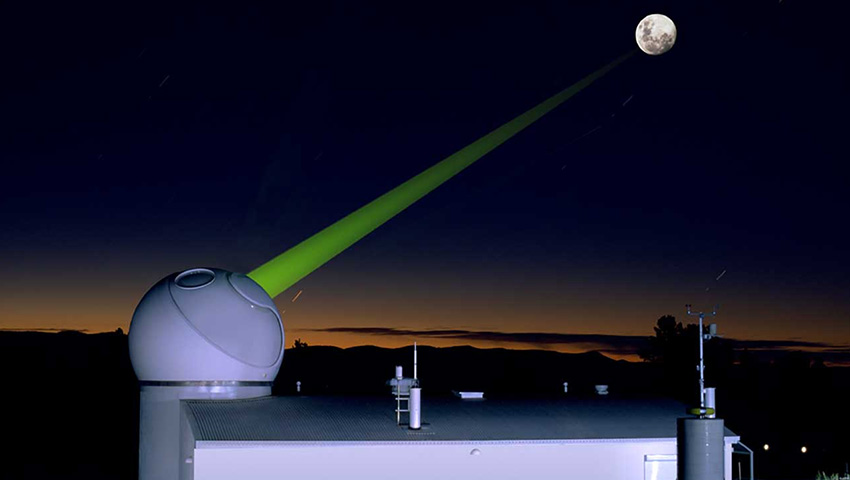Founded in 1983, EOS has developed systems for astrodynamic analysis, ground to space tracking of orbiting bodies and satellite laser ranging.
The company's heritage allows for the development of new technologies in support of space debris management and asset management in space, including orbit maintenance support.
Craig Smith, CEO EOS Space Systems told Space Connect, "EOS started as a space company in 1983, then in the mid 1990s the company split into the two branches: Space and Defence."
EOS Space focuses on a number of specialised products and services, including:
- Space surveillance: EOS utilises sophisticated satellite laser ranging technologies to conduct surveillance of space assets. Space surveillance focuses on space debris, or near-earth object (NEO) pollution.
- Space ablation: Focuses on the process of generating forces on objects by means of surface interactions with energy projected from a distant point. Laser beams, directed from the earth's surface to intersect with objects in space, generate significant forces if the interaction is carefully controlled.
- Observatories: EOS provides fully integrated observatory design, installation, commissioning and maintenance. EOS observatory designs are manufactured to international (ISO9001) standards and are optimised for thermal performance and can be provided in a kit form (standard design) or installed on site (custom design).
- Telescopes: EOS designs and manufactures state-of-the-art 'alt-az' telescopes as imagers, beam directors and trackers providing for the seamless integration of the telescope, telescope enclosure, instruments and software programs that are fitted with remote diagnostic support, automated operation.
- Satellite laser ranging (SLR): Involves firing and directing a very short laser pulse to reflect off a target satellite, usually off a retro-reflector to measure of the round trip time of flight is then used to determine the instantaneous distance from the telescope reference point and reflection point.
- Research and development: EOS conducts a number of research programs and is a proud research partner of the Space Environment Research Centre (SERC) which focuses on:
- Program 1: Identification of Space Objects and Preservation of the Space Environment;
- Program 2: Orbit Determination and Predicting Behaviours of Space Objects;
- Program 3: Space Asset Management; and
- Program 4: Space Segment.
EOS provides a variety of space debris and satellite management services throughout the life of the projects. This includes the design, manufacture and installation of specialised observatories for optical and laser tracking. EOS can take a greenfield site and transform it into an operational tracking station in less than 12 months.
"Space Situational Awareness is about knowing where everything in orbit is and what it is doing. It helps us to identify active satellites, dead satellites and debris to prevent and limit the possibilities of collisions in orbit," Smith said when explaining the importance of the specialised, accurate and reliable SSA services developed and provided by EOS.
The company's Australian designs include key SSA systems such as:
- High accuracy beam director telescopes;
- Laser systems;
- Imaging systems; and
- Pico-second time interval systems.
EOS develop and integrate fully autonomous software control for space sensor networks and provide SSA, object characterisation, space object cataloguing, high accuracy orbit determination and orbital projection, and conjunction assessments.
Ben Greene, EOS group CEO, said, "Information is our core business, our SSA program exemplifies this and EOS’ commitment to the field has grown over our 35-year history."
The launch of the Australian Space Agency (ASA) earlier this year is shaping up to be a key influencing force for the future direction of EOS Space. ASA's national civil space priorities focus on strengthening the nation's competencies and growing capabilities, particularly SSA and debris monitoring, communications technologies, services and ground stations, provides opportunities for EOS to expand their position as Australia's leading SSA provider.
"Australia has started engaging in the space domain at the right time. Access to space is increasingly being democratised, we are seeing a drop in the cost of accessing space, making it easier to access the domain," Greene said.
Further to this, Greene said, "As a nation, Australia has a natural advantage in space services, but we have to leave the door open to disruptive technologies being developed to help increase Australian access because in some of these disruptive technologies everyone, including Australia, is starting from the same basic levels."
Reinforcing the role of the ASA and the doors it will help open, Smith said, "The Australian Space Agency is a great opportunity for us to co-ordinate Australia's sovereign capability. It will make it easier for companies to collaborate with global agencies, as most agencies only engage directly with other agencies, so the ASA will help to break down those barriers."
If you would like to stay updated with all the latest new, market intelligence and analysis from the local space industry you can subscribe to Space Connect here.

